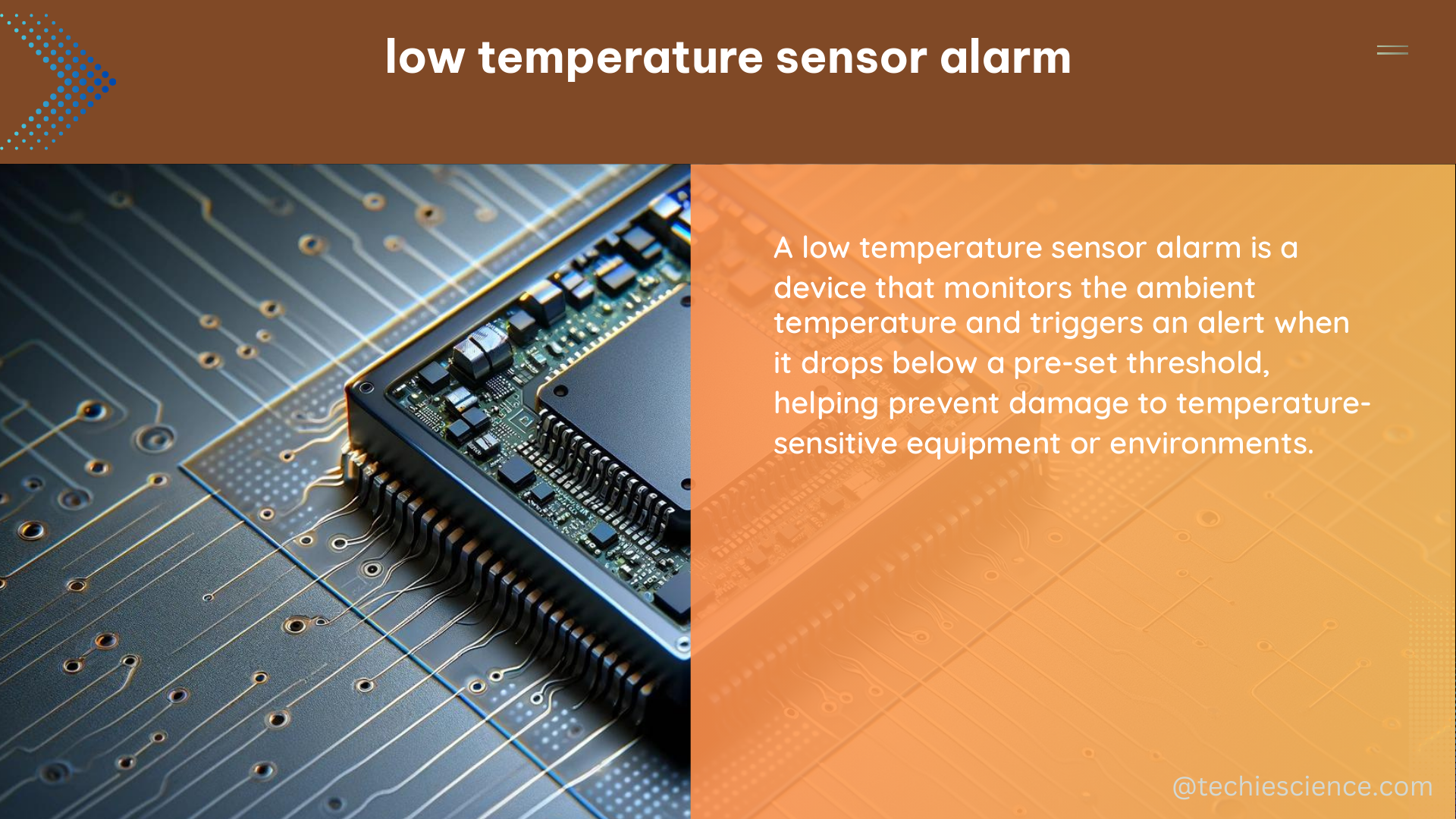Low temperature sensor alarms are essential for monitoring and maintaining optimal temperature conditions in various applications, such as industrial processes, cryogenic systems, and cold storage facilities. These alarms provide early warning signals to prevent damage to equipment, products, or even human injury due to extreme cold. In this comprehensive guide, we will delve into the technical specifications of low temperature sensor alarms and provide a detailed DIY implementation plan.
Technical Specifications of Low Temperature Sensor Alarms
Temperature Range
Low temperature sensor alarms should be capable of measuring temperatures ranging from as low as -200°C to as high as 200°C, with an accuracy of ±0.5°C or better. This wide temperature range ensures accurate temperature monitoring in diverse environments, from cryogenic storage facilities to high-temperature industrial processes.
Response Time
The response time of a low temperature sensor alarm is crucial for timely detection and prevention of temperature-related issues. Ideally, the alarm should trigger within 2 seconds of a significant temperature drop, allowing for immediate action to mitigate potential damage or injury.
Accuracy
Accuracy is paramount for low temperature sensor alarms, as even minor deviations can lead to false alarms or missed critical events. These alarms should have an accuracy of ±0.5°C or better to ensure reliable temperature monitoring and reduce the risk of unnecessary downtime or product loss.
Nuisance Alarm Reduction
To minimize false alarms, low temperature sensor alarms should incorporate advanced features to filter out rapid temperature fluctuations caused by environmental factors. This may include algorithms that can distinguish between genuine temperature drops and temporary changes due to factors such as sunlight, incandescent light bulbs, radiators, space heaters, HVAC vents, and hot pipes.
Alarm Communication
Rapid communication of alarm signals is essential for low temperature sensor alarms. These alarms should be able to communicate with the alarm station operator within 2 seconds of sensor activation, ensuring a timely response and minimizing potential damage or injury.
Power Supply
The power supply for low temperature sensor alarms should be reliable and have low power consumption. This can be achieved through the use of battery-powered systems or dedicated power sources, ensuring continuous operation and reducing the need for frequent battery replacements.
DIY Guide for Implementing Low Temperature Sensor Alarms

Step 1: Select the Right Sensor
Choose a temperature sensor that meets the specific requirements of your application. Consider factors such as the temperature range, response time, and accuracy. For example, a cryogenic storage facility may require a sensor capable of measuring temperatures down to -196°C, while an industrial process may need a sensor with a range of -50°C to 150°C.
Step 2: Choose the Alarm System
Select an alarm system that can effectively communicate with the temperature sensor and trigger an alarm when necessary. Ensure that the alarm system can rapidly communicate with the operator, reducing response times and minimizing potential damage or injury. Look for features such as programmable alarm thresholds, adjustable hysteresis, and the ability to integrate with existing building management or control systems.
Step 3: Install the Sensor
Carefully install the temperature sensor in the desired location, ensuring that it is protected from environmental factors that may cause nuisance alarms. Secure the sensor to prevent movement and ensure accurate temperature readings. Consider factors such as sensor placement, insulation, and shielding to minimize the impact of external influences on the sensor’s performance.
Step 4: Connect the Sensor to the Alarm System
Connect the temperature sensor to the alarm system, ensuring that the communication between the two is reliable and rapid. Test the connection to verify that the alarm is triggered when the temperature drops below the desired threshold. Utilize features such as self-diagnostics and remote monitoring to ensure the system’s ongoing reliability and performance.
Step 5: Test the System
Regularly test the low temperature sensor alarm system to ensure that it is functioning correctly. This may include simulating temperature drops and verifying that the alarm is triggered as expected. Maintain detailed records of system performance, including any issues or maintenance activities, to optimize the system’s reliability and effectiveness over time.
By following this comprehensive DIY guide, you can implement a reliable and effective low temperature sensor alarm system that meets the specific requirements of your application. Remember to consult relevant industry standards, regulations, and best practices to ensure compliance and maximize the safety and efficiency of your system.
References
- Air Force – AF.mil, (2023-10-16). dafi10-2501.pdf. Retrieved from https://static.e-publishing.af.mil/production/1/af_a4/publication/dafi10-2501/dafi10-2501.pdf
- NRC.gov, (n.d.). NUREG-1959 “Intrusion Detection Systems and Subsystems. Retrieved from https://www.nrc.gov/docs/ML1111/ML11112A009.pdf
- ACQnotes.com, (2005-08-03). DoD Reliability Availability and Maintainability (RAM) Guide. Retrieved from https://www.acqnotes.com/Attachments/DoD%20Reliability%20Availability%20and%20Maintainability%20%28RAM%29%20Guide.pdf
- Lakeshore.com, (n.d.). Temperature Measurement and Control Catalog. Retrieved from https://www.lakeshore.com/docs/default-source/product-downloads/lakeshoretc_l.pdf

The lambdageeks.com Core SME Team is a group of experienced subject matter experts from diverse scientific and technical fields including Physics, Chemistry, Technology,Electronics & Electrical Engineering, Automotive, Mechanical Engineering. Our team collaborates to create high-quality, well-researched articles on a wide range of science and technology topics for the lambdageeks.com website.
All Our Senior SME are having more than 7 Years of experience in the respective fields . They are either Working Industry Professionals or assocaited With different Universities. Refer Our Authors Page to get to know About our Core SMEs.